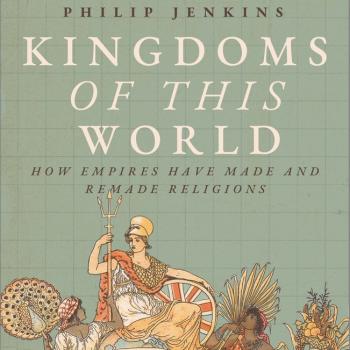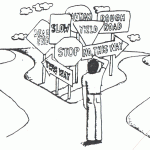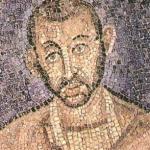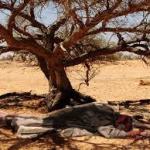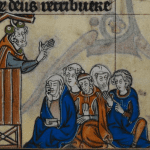In my last post, I tried to identify some of the universals in human nature that supply the foundation for much religious behavior, whether we are looking at the great world faiths, or traditional primal religions. Let me here offer some of the specific examples, of what I call the “building blocks” of faith, and of faiths. What features do all human beings have in common, which taken together provide the components of a kind of default religion? There are more such universals that we might immediately think. Together, they provide a useful structure for thinking about and teaching religion and religious behavior.
As I said in that earlier post, I am not trying to use any kind of reductionist approach, to suggest that religion is entirely a matter of neurons. Having said that, human nature does entail certain features and characteristics that predispose all human beings to religious concepts and behaviors, and in that sense, they do offer the building blocks of faith and faiths.
1.Natural Religion?
Certain forms of popular religiosity seem – to use an unfashionable word – “natural,” integral to human nature.
Even in an advanced post-industrial nation like the US, we can find a very large range of popular practices and behaviors that resemble those of primal religions, as well as of the underlying strata of other world religions. Though unexamined, popular religiosity has much in it that is broadly “primal”. In fact, such examples are so abundant as to raise serious questions about the definition of the term “religious”. Is a belief in Santa Claus religious? Is UFO belief religious? If you can “desecrate” a US flag, does that mean that it is a religious object? Just what – if anything – is the difference between “superstition” and “real” religion? Who decides?
Lots of seemingly “primal” examples can be cited here, including the ubiquitous practice of throwing coins in fountains or other convenient bodies of water. We might think of the practices of visitors to monuments and memorials, such as the Vietnam Memorial, which is obviously seen as a point of contact between living and dead. People reflect this belief by leaving all manner of goods and objects for the dead.
Another good example of non-specific religiosity is the kind of popular shrine that appears at the site of a great tragedy, at which people leave flowers, teddy bears and so on. Or we might take the folklore surrounding such sites, the means by which urban legends develop: September 11 produced a very rich crop of such outpourings – including beliefs about omens, psychic linkages, and so on. Regardless of their formal religious affiliation or belief, people share common non-rational ideas about phenomena like violent death. Though these responses are commonly listed under headings like “superstition”, they are in fact very close indeed to what in other societies would be formal religious activities and myth-making.
2.Being Ourselves
We can then try to explain what we have in common as human beings that explains these very broad cross-cultural similarities.
Most basic to human consciousness is the sense of self: we exist, we are. This self-consciousness encourages a belief in an absolute reality of self external to the body. That does not mean that all societies have a belief in personal immortality, but the notion of a soul or souls separate from the vehicle of flesh and blood is very common.
If there is a soul, must it be linked to the body at all times, or may it travel freely through other realms, waking or sleeping?
In addition, we are born and we die. This core identity that we possess must have come from somewhere, some other realm, and it must continue somewhere in some form. Intellectually, we know that we will die, but it is literally impossible for us to imagine our own non-existence. Even when we imagine our deaths, we do so in a form that supposes we are consciously watching the proceedings, observing the mourners leaving the graveside. If we imagine the grave, we see ourselves in some kind of extended sleep. We know that our identity must continue somewhere, in some form, giving rise to widespread ideas of an afterlife, perhaps in the form of reincarnation, of varieties of heaven and hell.
If other people die and yet they somehow continue their existence, then we living people have to find some form of interacting with those beings, who might be far more powerful and dangerous than they ever were in life. That might mean comforting or controlling those beings, to ensure that they make their proper journeys to whatever their final destinations might be. In various ways, they need our help, and they in turn can help us.
Finally, humans are children for a very long portion of their existence. Compared to other mammalian species, we spend a large proportion of our lives in a state of utter physical and psychological dependency on a larger and all-powerful figure or figures. Observers have long suggested that this fact contributes mightily to our willingness to hypothesize the existence of gods, angels, or superior figures, sources of wisdom and guidance. In earlier societies – though less in the modern world – the collective assemblage of ancestors and precursors serve this function.
3.Body, Breath and Blood
Some of the “universals” arise from the nature of the human body.
From earliest times, people learned to associate the fact of life with our physical characteristics. Most obviously, we bleed, and when we bleed, we lose strength and vigor. We know that our continuing identity is dependent on the survival of crucial parts of this organism, which we identify with the basic forces of life. When we identify blood as the source of life and strength, we have prepared the way for many cultural associations and activities, including the symbolism as red as a color of force and power. Very early in human societies too, the connection between blood and lunar cycles offered clear evidence of the linkage between the body and the universe, macrocosm and microcosm. Survival of our families or communities depends on dealing with the powerful forces of sexuality, in which we transmit the life force no less than life itself.
In addition to blood, the obvious connection between breathing and life demonstrated the significance of air and spirit. Human forces were linked to the natural world, and sickness was connected with those outside powers. All humans fall sick, and we know that spiritual forces can effect cures. Throughout modern history, the story of new religious movements in the West is commonly the story of the quest for spiritual healing, a gift seemingly refused by the mainstream faiths. Potentially “spiritual” concepts are also built in to the facts of our existence. We all eat to live: that is, we survive by eating other things that have been living, plants or animals. The death of others gives us life. This exchange demands reciprocity and exchange, perhaps through sacrifice, but at least through gratitude to higher powers. Once again, new religious movements have often been in the vanguard of struggles for new attitudes to food and eating, expressing a “natural” concern excluded from mainstream religion.
We perhaps see “universal” roots of religious or superstitious activities such as sacrifice, blood taboos, exorcism, theories of possession, and spiritual healing.
4.Altered States
We can experience altered states, which we commonly identify with supernatural or spiritual realities.
As recent work on neurochemistry has reminded us, we are programmed to feel awe and exaltation, and these feelings suggest the presence of the special, dreadful and numinous, qualities that are located in particular persons, events, and places. We believe that some people are intrinsically closer to the higher realms. We visit holy places to seek the powers there, to draw from the merits of holy people. Likewise, we seem to know dread as well as awe, and possess a powerful sense of the evil inherent in places, to be shunned or tabooed. In insanity and personality disorders, we see other forms of “alteration”, which all too plausibly indicate the presence of new and hostile spirits who have displaced the true owner of the body in question.
Just as fundamental is the universal fact of dreaming, which tells us of other states of consciousness and reality beyond the everyday world. Our souls travel. In dreams, the boundaries of reality collapse: animals can speak, the dead walk. We see here confirmation of higher and lower realms. In terms of primal religions, these facts sustain the belief in the Otherworld, the Dreamtime, in shamanism. Depending on the society, there are many ways of knowing altered states of consciousness, including fever, trance, drunkenness, or extreme stimulation. In such states, people believe they see visions and defy time, defy the borders between life and death.
This all helps explain the origin of such fundamental aspects of religious thought as holiness, prophecy, and visionary experience.
On a more everyday level, humans are very good at techniques that promote a sense of community, solidarity, elevation and exaltation. These methods include music, dance, or shared physical movements; and multiple means of appealing the senses of hearing and sight, sound and smell. I have written about this elsewhere in the context of Christian liturgy.
When people try to convey the truths they learn in these other states, they do it by the standard means that humans try to make sense of the incomprehensible: they tell stories, they make myths and legends, they perform and re-enact. As Andrew Greeley remarked, religion was “experience, symbol, story (most symbols were inherently narrative) and community before it became creed, rite and institution.”
5.Making Sense of the World
In our relations with the outside world, we naturally think and behave in ways that seem magical and even primitive.
We might cite the trivial example of arguing or pleading with a computer (“Please, please, don’t wipe that data”), but time and again, we see examples of human beings projecting our own realities. We think magically and analogically. We tend to believe in rational order: that there is a proper order of things, which if disturbed must be set right.
We also look for significance, and (despite all evidences to the contrary) we find it. We believe in correspondence, in special arrangements of order, which often depend on numbers. Numerical correspondences again reflect the human body, for instance the widespread beliefs concerning the numbers five and ten. We look for order, and often we find it in the natural world, the skies. Though our climate and geography varies, humans everywhere share some absolutely common external realities, in the form of sun, moon and stars.
We believe in reciprocity, hence the bargaining that so often marks our irrational processes. We assume that other beings and things must operate and think and act in ways comprehensible to us – in religious terms, we observe the principles of anthropomorphism and animism. These processes are powerfully obvious from our treatment of animals. We observe and interact with animals, try to think ourselves into their powers and attributes, and know that they must somehow interact with the Otherworld in various ways.
Similarly, we believe in rational agency. We believe that things happen to us through the action of others, conscious or otherwise. In many societies, this idea of cause and effect gives rise to notions of witchcraft and all the attendant cures and protections.
6.Looking High and Low
Finally we can look at how these “primal” themes were transformed by the impact of literacy, and observe the shift to scripture- and clergy-based religions. The Old Testament offers a lot of striking examples of this kind of transformation, as a highly text-bound book seeks to convey the experiences of an oral and primal religion, often with some jarring inconsistencies resulting from the interface. We can draw parallels with other major religions, especially Buddhism.
What happens to natural religion in this new world of Texts, Tombs and Temples?
In summary, I have been talking about the building blocks of religion, those universal human experiences that underlie religious behavior. Let me here present these in a simple table, of a kind that I have personally found useful in teaching.
- We ARE. We exist. We are conscious of a distinct identity. (soul)
- We are born. This identity we possess must have come from somewhere.
- We are children. We spend a large proportion of our lives as children in a state of utter physical and psychological dependency on a larger figure or figures. (gods; God)
- We die. We know we will die, but we cannot imagine our own non-existence. We know that this identity must continue somewhere, in some form. (afterlife; reincarnation)
- We get sick in mind or body. We need to know the cause of these conditions, and to seek help and healing. (exorcism; possession)
- We bleed. We know that our continuing identity is dependent on the survival of crucial parts of this organism, which we identify with the basic forces of life.
- We dream. We know that there are other states of consciousness and reality other than the everyday world. (otherworld; dreamtime)
- We experience other altered states of consciousness. This might arise from fever, trance, drunkenness, or extreme stimulation. (trance; vision)
- We tell stories. We use narrative to make sense of the world around us (myth-making)
- We project our own realities. We assume that other beings and things must operate and think and act in ways comprehensible to us. (anthropomorphism; animism)
- We believe in rational agency. We believe that things that happen to us occur through the action of others, conscious or otherwise. (witchcraft)
- We think magically and analogically. (magic)
- We believe in rational order. There is a proper order of things, which if disturbed must be set right. We believe in reciprocity. (sacrifice)
- We eat. We survive by eating other things that have been living. The death of others gives us life. This exchange demands reciprocity and exchange.
- We reproduce. Survival of our families or communities depends on dealing with the powerful forces of sexuality, in which we transmit the life force no less than life itself. (fertility).
- We feel awe. We recognize the presence of the special, dreadful and holy, qualities that are located in particular persons, events, and especially places. (numinous; holiness)
Reading this, I think back to a somewhat similar list I offered not long back, of the residual ideas and practices that remain when formal religion disappears. Those basic themes persist – what I called “default religious practice.”







